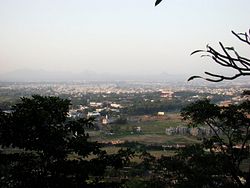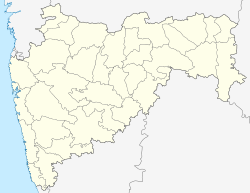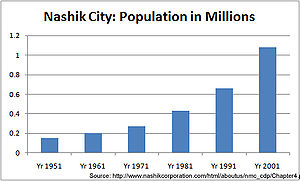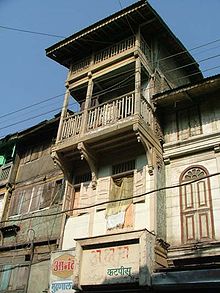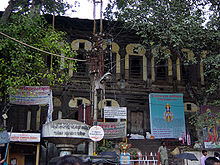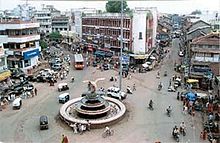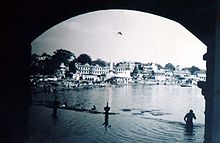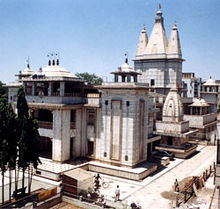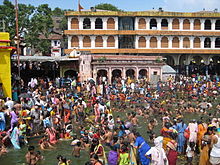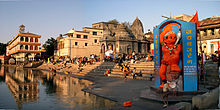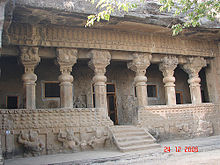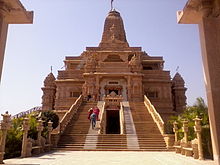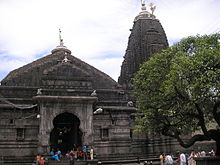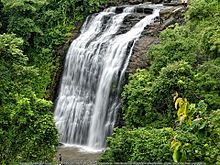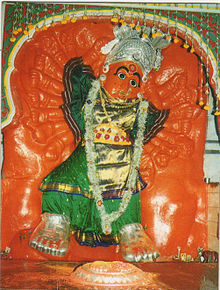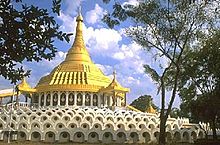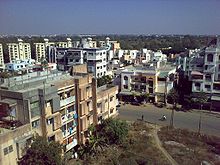- Nashik
-
This article is about the municipality in Maharashtra, India. For its namesake district, see Nashik district.
Nashik
Nasik, (नाशिक)
Wine Capital Of India — metropolitan city — Nashik city view from the Pandavleni Caves Coordinates 20°01′N 73°30′E / 20.02°N 73.50°ECoordinates: 20°01′N 73°30′E / 20.02°N 73.50°E Country India State Maharashtra District(s) Nashik Divisional Commissioner of Nashik Jayant Gayakwad Collector of Nashik P. Velarasu Mayor Nayana Gholap Population
2,195,860 (21) (2010[update])
• 8,310 /km2 (21,523 /sq mi)
• 1,832,195 (17th) (2009[update])Time zone IST (UTC+05:30) Area
264.23 square kilometres (102.02 sq mi)
• 561 metres (1,841 ft)
Website nashik.nic.in/ Nashik or Nasik (Marathi - नाशिक) (
 pronunciation (help·info))[1] is a city in Maharashtra, India. Nashik is located in the northwest of Maharashtra, 180 km from Mumbai and 202 km from Pune. Nashik is the administrative headquarters of Nashik district and Nashik Division. Nashik, which has been referred to as the "Wine Capital of India",[2] is located in the Western Ghats, on the western edge of the Deccan peninsula on the banks of the Godavari. It is claimed to be the fastest growing city in Maharashtra. Nashik has prospered the most in the past 20 years.
pronunciation (help·info))[1] is a city in Maharashtra, India. Nashik is located in the northwest of Maharashtra, 180 km from Mumbai and 202 km from Pune. Nashik is the administrative headquarters of Nashik district and Nashik Division. Nashik, which has been referred to as the "Wine Capital of India",[2] is located in the Western Ghats, on the western edge of the Deccan peninsula on the banks of the Godavari. It is claimed to be the fastest growing city in Maharashtra. Nashik has prospered the most in the past 20 years.In addition to supplying the name to the famed Nassak Diamond,[3] the city is known for its picturesque surroundings and pleasant climate. The Godavari River flows through Nashik from its source, which lies to the southwest of the city, in Trimbakeshwar . Nashik Urban Agglomeration (Nashik UA) has a (projected year 2009) population of 1,995,860[4] and a total area of 264.23 km²[5] which makes it the fourth largest urban area in Maharashtra in terms of population. Nashik is the third most industrialized city in Maharashtra after Mumbai and Pune .[6]
Nashik is one of the world's holiest Hindu cities. Kumbhmela is held here once in 12 years along with four other cities in India. Lord Rama along with Lakshmana and Sita spent 14 years of his exile at Tapovan near Nashik. The city came under the rule of Mughal in 16th century and was renamed Gulshanabad. Then it comes under Peshwa of Maratha Empire in 1818. It is also noted for its participation in freedom struggle. Freedom fighters like Veer Savarkar and Anant Laxman Kanhere were born in Nashik.
Known for its beautiful and picturesque surroundings, flourishing valleys, Nashik is home to many vineyards and orchards. Today, Nashik is rated as one of India's fastest growing cities. The city saw a fast uplift of development from 2002 with malls, multiplexes, infrastructure, educational institutions etc. Nashik is known for its pleasant and cool climate, picturesque surroundings, high standard of living, greenery and well-developed infrastructure.
History of Nashik
Hindu religion has it that Lord Rama the King of Ayodhya made Nashik his home during his 14 years in exile. At the same place Lord Laxman by the blessing of Lord Rama cut off the nose of Surpanakha and thus this place was named as "Nasik"(From Sanskrit word 'Nasika'). Several other references to the Ramayan era can be found in Nashik, which includes the Sita Gumpha from where Sita Lord Rama's wife, was abducted by Ravana. Nashik was believed to be the country's largest marketplace.The city got its present name in 1818 .
Some of the major events in history of Nashik in the 1860s are.
- 1862 : Nashik Road railway station was built.
- 1864 : Nashik Municipality formed
- 1869 : Nashik district formed.
Nashik also participated in the freedom struggle of India. On December 21, 1909, 17-year-old Anant Laxman Kanhere shot the Collector of Nashik Jackson in a theatre named Vijayanand theatre, where he had gone to see a play Sharada.Jackson died on the spot. The people involved in the incident, Anant Laxman Kanhere, Krishnaji Karve and Vinayak Ramchandra Deshpande were sentenced to death by hanging and were hanged soon after.
In 1914, Karmveer Ravsaheb Thorat, Bhausaheb Hire, Annasaheb Murkute, founded the Nashik District Maratha Vidya Prasarak Samaj (NDMVP), prominent educational institute in Nashik. The founders name was later give to K.T.H.M. college. The K.R.T. Arts, B.H. Commerce & A.M. Science College, Nashik (Popularly known as KTHM College) was established in 1969. The College is situated on magnificent campus on the bank of river Godavari.
Nashik is located in northern Maharashtra at 600m (1 968 ft)[7] from the mean sea level.
The river Godavari originates from Trimbakeshwar (24 km from Nashik) and flows through various parts of the city. The river forms the northern boundary of the city in some areas and then flows through the old residential settlement in the city.Nashik lies on western edge of the Deccan Plateau which is a volcanic formation.[8] The soil here is primarily black which is favorable for agriculture. Prashant Koli, India's renowned Agricultural Scientist said;" It's the best in North Maharashtra Region due to its iconoelasticity" The total land area of the city (Municipal Limits) is about 259.13 km2[5] which makes it the third largest urban area of Maharashtra after Mumbai Metropolitan Region and the Pune and Pimpri-Chinchwad Urban Region (together as Second) i.e. Pune Metropolitan Region.
Contents
Climate
Nashik has a mild climate for most of the year apart from the hot summers which last from March to mid-June. The city has a semi-arid climate under the Koppen climate classification. The period from June to September is the (South West) Monsoon Season, which sees about 620 mm (25 inches) of rain. The city experiences a mild, dry winter from November to February, with warm days and cool nights, although occasional cold waves can dip temperatures. The maximum temperature ever recorded in the city was 44.8 °C (108.3 °F) on 12 May 1960 in Nashik. The lowest temperature recorded was 0.6 °C (33.1 °F) on 7 January 1945 in Nashik. [1]
Climate data for Nashik Month Jan Feb Mar Apr May Jun Jul Aug Sep Oct Nov Dec Year Average high °C (°F) 29
(84)31
(88)35
(95)37
(99)37
(99)32
(90)28
(82)27
(81)29
(84)32
(90)31
(88)29
(84)31.4
(88.6)Average low °C (°F) 10
(50)12
(54)16
(61)20
(68)22
(72)23
(73)22
(72)21
(70)21
(70)18
(64)14
(57)12
(54)18
(63.6)Precipitation mm (inches) 1.1
(0.043)0.4
(0.016)3.4
(0.134)6.7
(0.264)16.2
(0.638)98.1
(3.862)206.4
(8.126)134.6
(5.299)146.1
(5.752)49.0
(1.929)21.3
(0.839)7.2
(0.283)690.5
(27.185)Source: wunderground.com[9] Demographics
According to the Census of India, 2001, Nashik had a population of 1,152,326. Males constitute 54% of the population and females 46%. Nashik had an average literacy rate of 74%, higher than the national average of 64%; male literacy was 80%, and female literacy was 66%. In Nashik, 14% of the population is under 6 years of age. In the same year (census year 2001) the Nashik Urban Agglomeration had a population of 1,152,326[10] and thus it was the fourth largest urban area of Maharashtra State after Mumbai and Pune and Nagpur. The projected population of Nashik urban agglomeration (which includes abutting urban areas like Deolali) as on 1 January 2009 is 19,95,860.[4] Only 3% of Nashik lives in Slum.22 oct 2010
Administration
Nashik is the headquarter of Nashik District and is also the headquarter of Nashik Revenue Division of Maharashtra. The city is administered by the Nashik Municipal Corporation which came into existence in 1982 by combining Nashik Municipality and surrounding civic bodies e.g. Nashik Road Municipality. A planned area was introduced in Nashik which was designed by CIDCO which is now administered by the Nashik Municipal Corporation.
Deolali, which is also a part of the Nashik urban agglomeration, has a separate civic body called the Deolali Cantonment Board.
Environment
Solid Waste Management Project from the Nashik Municipal Corporation[11]
In the entire Nashik Municipal Corporation area about 225 MT of solid waste is generated per day. A system is in place which has made the city a 'garbage dump free' city.
A plant has been set by the Nashik Municipal Corporation near the city to process the garbage and convert into compost.
Rain water harvesting enforcement by the Nashik Municipal Corporation[12]
The Nashik Municipal Corporation has made it mandatory for new constructions in the city to install a rain water harvesting system without which a completion certificate is not granted to the construction. This measure is expected to help recharge the aquifers and augment the ground water level in the city.Cityscape
The older quarters of the city are peculiar to many similar cities of Maharashtra such as Pune, Satara and Kolhapur. It is characterized by the wadas (a housing typology, wada would mean a courtyard house), narrow, shaded, winding streets, peculiar projections onto the street, streets swelling into a chowk (public courtyard) and the vibrant and active bazaar (market) streets leading towards the river (in many cases). Streets are identified by the goods they sell and still attract large number of buyers from the city and more so from adjoining towns and villages.
Architecture
- Rock-cut architecture
Rock-cut caves called Pandavleni Caves relating to Hinayana Buddhism are located near Ambad, about 10 km from the city center. The caves are believed to be carved out between 1st century BC and 3rd century AD. There are 22 caves which comprise chaitya and vihara with varying levels of carving and detail.
Chambharleni is another location of Jain rock-cut caves near Mhasrul, about 8 km from the city center. - Temples of Nashik
The city is home to hundreds of temples and shrines notably at the Ghats near Ramkund (which is the stretch of the river considered holy as it changes its course from westward to southward). The Kalaram Temple, The Naroshankar Temple and the Sundernarayan Temple are most significant architecturally, all built in black basalt stone. Trimbakeshwar temple is 30 km from Nashik. - Traditional Wada structures of old Nashik
The old city's housing quarters primarily comprise the wada design. These are built-to-edge courtyard houses with rooms built around a central (multi-activity) courtyard opening onto the street. This design is a fine example of climate control and resulted in the peculiar urban form of narrow shaded streets and public courtyards. - Contemporary Residential Architecture
The urban form of outer Nashik used to be dominated by (generally) well-designed two story independent houses. As land costs soared these have been replaced by either row houses (houses with common side walls) or multistory apartments. The last decade has witnessed a trend of clusters of multiple buildings with a mix of typologies served by common amenities like a club and a swimming pool. - Contemporary Institutional and Public Architecture
There are a few architecturally notable public buildings in Nashik like The Nashik Municipal Corporation Administrative Headquarter, The Kusumagraj Smarak and The Dadasaheb Phalke Memorial at the foothills of Pandavleni Caves. Some of the recent projects, educational campuses and corporate buildings, have demonstrated reasonable architectural flair at par with national and international architectural trends.
Prominient Personalities
- Mahadev Govind Ranade, a famous personality of British India and former Judge of Bombay High court.
- Sripad Amrut Dange, founder of Communist Party of India and Leader of Samyukta Maharashtra Movement.
- Kusumagraj, a famous and great Marathi poet.
- Dadasaheb Phalke, founder of Cinema of India
- Tatya Tope, A great freedom fighter
- Veer Savarkar, A freedom fighter, writer and poet.
- Anant Laxman Kanhere, a freedom fighter
- J. D. Bytco - a local Industrialist, founder of Muktidham and educational institutes lik D. D. Bytco Higher Secondary School and J. D. Bytco Commerce & Science Collage & J.D. Bytco Institute of Management Studies in Nashik.
Art and literature
City has a long artistic tradition. Nashik has one of the biggest public libarry named Sarvajanik Vachanalay Nashik. Nashik is known for its Art and literature contribution.
- MovieShri Dadasaheb Phalke - the founder of the Indian Film industry comes from Nashik. He started movie making in India with the on mythological character “Raja Harishchandra” in 1913. This was the first movie in India. He made 95 movies and 26 short films in the span of 19 years, till 1932 in Nashik.
- Music Pt. Vishnu Digambar Paluskar was a genius from Nashik, who wrote books on classical Indian music in Marathi language. The books were then translated in Hindi and English. He reinvented notation system suitable to Indian classical music. He also composed notations for the national anthem of India. Another famous patriotic song “Sare Jahanse Achha” is also composed by him.
- LiteratureBahinabai Chaudhary was a poetess who made poems in spoken Marathi. It was a flawless creation in ample. Once her son realised the value of her poems he started writing it down. Her poems is an invaluable treasure of Marathi literature. The poems reflect real day-to-day life in a rural setting describing the beautiful effects of nature on her life. She also state the phiolosophy of life in simple humble words.
- Literature Mr V V Shirwadkar alias“Kusumagraj” - In a career spanning five decades starting in pre-independence era. He wrote in Marathi language, 16 volumes of poems, three novels, eight volumes of short stories, seven volumes of essays, 18 plays and six one-act plays.[2] His works like the Vishaka (1942), a collection of lyrics, inspired a generation into the Indian freedom movement,[3] and is today considered one of the masterpieces of Indian literature.,[4] apart from his play, Natsamrat which has important place in Marathi literature.
- Literature Vasant Kanetkar was a stage drama writer in Marathi language. He wrote 40 three-act plays, all of which were performed on the professional stage. Many of his plays became high commercial successes. He has been credited with rejuvenating the Marathi theatre when it was in decline, the age of Sangeet Natak (stage musicals) having had come to an end.
- Literature Vinayak Damodar Savarkar re-wrote indian history from a patriotic point of view. His works are in Marathi language, Saha Soneri Pane (Six golden pages in the History of Hindu Nation) - explaining six Indian empires and their extent. He wrote many other books. Kale Pani" (Black water) - a novel based on his experiences in Andaman. "Mala kay tyache" (What do I care?), on the background of the mutiny of Mopla- Muslims in Malbar. He wrote two books in English named "Hindutwa" and "Hindupadapadshahi" on the history of Marathas. Two of his poems famous are Sagara Pran Talamalala and Jayostute sung by Lata Mangeshkar
Tourism
Nashik has been on the tourist map of India especially Hindu religious tourism because of the legend that Lord Rama lived here during his exile. Gangapur Road, College Road and Trimbak Road form the lifelines of the suburbs. For many, Nashik is just a pit-stop en route to Shirdi or Trimbakeshwar. If one decides to stop and look around the city and its outskirts, there's plenty to see. The Gangapur Dam is a beautiful site. The Dudhsagar Fall near the village of Gangapur is worth a look in the rains. A few kilometers away from Gangapur village is a Stone Age site. On the road to Trimbakeshwar is the state's only Museum of Numismatics. Anjaneri Parvat near Trimbakeshwar is well known for waterfalls during monsoon season. Pandavleni Caves, the 4th century BC caves of Buddhist origin, a Bird Sanctuary "Nandur-Madhyameshwar" popularly known as "Bharatpur of Maharashtra", which was started in 1950s, is a little ways from the city and is a mesmerizing place for nature and bird.
Tourist Attractions in Nasik
Godavari Ghat The Godavari is a river that runs from western to southern India and is considered to be one of the big river basins in India. It originates near Trimbak in Nashik District of Maharashtra state and flows east across the Deccan Plateau into the Bay of Bengal near Rajahmundry in East Godavari district of Andhra Pradesh. It enters Andhra pradhesh at Kandhakurthi in Nizamabad District, crosses the Deccan Plateau and then turns to flow in a southeast direction until it empties into the Bay of Bengal through two mouths. Basara, on the banks of Godavari in Nizamabad District, is home to a famous temple for Goddess Saraswathi and is only to the second temple for the Goddess in India. The Godavari River has a drainage area of 313,000 km² that includes more than one state. The Indrawati, Wainganga, Waradha, Pench, Kanhan and Penuganga rivers, discharge an enormous volume of water into the Godavari system. Its tributaries include Indravati River, Manjira River, Bindusara River and Sabari River. the Godavari River is sacred to Hindus and has several pilgrimage centers on its banks. It has been held as a special place of pilgrimage for many thousands of years. Many famous personalities, including Baladeva (5000 years ago) and more recently Chaitanya Mahaprabhu (500 years ago) have bathed in her waters as an act of worship.
Godavari Temple The Godavari Temple was built by Elder Madhavrao Peshwa's mother, Gopikabai in 1760. This temple is open for devotees only during the period of Kumbhamela (once in 12 years) for 13 months. It is also called Ganga Temple.
Muktidham
Muktidham is the pink marble temple, situated about 9.9 km. away from the Nasik town. This temple depicts all important places of pilgrimage in India. All deities are prepared according to the size of the original deities from the respective holy places. These deities have been duly sanctified by sending them to the original pilgrim centres.
Panchvati
Panchvati is situated about 2 km. away from the Nasik town. The name ‘Panchvati’ is derived from the words Panch which means five and Vati which means banyan tree. Sita Gumpha is situated nearby where Sita, had once taken refuge. There are many temples here such as Kala Ram, Kapaleshwar, Ganga Godavari, Sunder Narayan, Vithal, Pataleshwar and Naroshankar.
Seeta Gufa Seeta Gufa is a narrow cave in Panchvati. It is said that Seeta stayed in this cave for some days during Vanvas. The entrance of this gupha is small, a bit narrow and a little slopy but it's easy to enter here. The entrance and the exit are separate. The deities of Ram, Seeta and Laxman are placed inside the first main gupha. In the second small gupha there is a Shivling(icon of God Shankar). The main reason attributed for the Shivling is the fact that Seeta used to worship God Shiva and she never took her meals before worshiping him. So for her convenience Shivling was placed in that gupha. A room opposite to Seetagupha is decorated with the scenes from Ramayana like Marich Vadha (i.e. Ram Killing Marich, the demon.), Seeta Haran (the kidnapping of Seeta by Ravan). It is said that Ravan kidnapped Seeta from this place.
Ramkund-
Built in 1695, Ramkund is a holy tank. Chitrarao Khatarkar got it constructed 27mts. by 12 mts. It is believed that, Lord Rama and his consort Sita used this tank for bathing during the years of exile. There is a common belief that if the ashes are immersed in the holy waters of this kund, salvation or moksha is easily achieved.
Kalaram Mandir-
This temple was built in 1794 and is similar in its architectural design to the nearby Trimbakeshwar Temple. The temple is 70 feet in height and was the brainchild of Gopikabai Peshwa. It was built with black stone from the mines of Ramsej Hill. There is a beautiful gold-plated copper peak on the temple. There are icons of Rama, Sita and Laxman lavishly adorned with adornments. The temple is surrounded by several smaller temples such as the Vithal Temple, Ganapati Temple and Maruti Temple.
Pandav Leni-
Pandav Leni are the Hindu caves, situated about 2 km. away from the Nasik town. It consists of 23 caves which contains beautiful medieval sculptures. Out of these caves, the most famous are caves 3, 8, 10, 15, 17, 18 and 21.
Someshwer temple- Someshwar Temple is situated about 9 km. away from the Nasik town. This temple is dedicated to Lord Shiva and situated on the banks of the Godavari river.
Tapovan Tapovan is a beautiful picnic spot where Rama, stayed during his exile. At this place, Sita, his consort was also abducted by the Ravana. This place is situated about 3 km. away from the Nasik town. Tapovan is the only Laskshman temple and becomes unique in this way.
Kapaleshwar mandir- Kapaleshwar Temple is situated exactly opposite Ramkund. This was built in 1728. Kapaleshwar is another name for God Shankar. There is always an icon ok bull calf (Nandi) in each Shiva's Temple but this is the only temple without a bull calf.
SundarNarayan Mandir- The Sundarnarayan Temple is built by Gangadhar Yashwant Chandrachud in 1756. The entrance is at the East. The two Mandaps may be small but the architecture is attractive. The arched recess seems to be inspired by the mougal style of architecture. The main deity in the temple is that of Vishnu Narayan. To its left and right are the deities of Laxmi and Saraswati. The important peculiarity of the temple is the angle of construction which makes the first rays of the sun to fall exactly on the foot of deities on 21 March.
NaroShankar Mandir- The temple was built in 1747, and initially named as Rameshwar. The name was changed to NaroShankar later on. A historical reason is cited behind this change. In the last years of Maratha Regime Bajirao Peshwa's brother Chimaji Appa and his sardar Naroshankar, who were great warriors, fought with Portuguese and won over the fort of Vasai(Basin). Then as a token of their bravery they brought the Church Bell (Ghanta) from Vasai to Nasik, and hanged it in front of this temple. The bell is here and the remembrance of Naroshankar is kept alive.
Bhaktidham- Old name of Bhaktidham was Kailas Matha. At the left of the entrance the wall is decorated with the paintings of Atrik Rishi's Ashram and Ram, Seeta and Laxman in Panchavati. The main deity is that of Pashupatinath ( i.e. Shankar). Other deities are of NarNaryan, Virat Darshan and Ram, Seeta, Laxman. Also deities of Gopal Krishna, Radha, Vitthal, Nar Narayan, Dutt are present there. Most of them are made by using marble. In fact it is a temple which gathers many of the God of Hindu Religion.
Akshardham Near Tapovan, on Agra road the Swami Narayan temple or Akshardham is located. Years ago, this was Bramhachari (Bachelor's) Ashram. The trustees of the temple run a school in the Sanskrit medium.
Modakeshwar Ganesh Temple- The Modakeshwar Ganesh Temple is another famous temple of Nasik. The idol in the temple is believed to be self emerged and is also known as 'Swaymbhu'. The temple derives its name from the 'Modak' a special Maharastrian dish made of coconut and jaggery. This dish is considered to be Lord Ganesh's favorite.
Dadasaheb phalke samarak-The Dadasaheb phalke samarak is named after Dadasaheb Phalke, a lengend in the history of Indian Cinema. Samarak is spread across 29 acres, placed in the sourroundings of pandava caves, which has a conference hall, a meditation hall, an exhibition center and a beautiful garden. The Samarak also has the works of Dadasaheb Phalke.
Jain Mandir- A huge newly built temple complex dedicated to Jain saints, Jain Mandir is located at Vilhouli, Nasik. This pretty three-storied shrine presents a different architectural grandeur than that of the other temples. Shree Dharmachakra Prabhav Tirth, which is popularly called as Jain Mandir is constructed with white marble and pink sand. One among the deities of this Mandir is the 24th thirthankara of the Jains. This amazing deity weighs 12 ton and it is made up of Panchdhatu. Situated in a serene ambience, all the idols enshrined in this temple adorns a serious outlook.
College Road-happening place in Nasik. Malls, Restaurants, Shopping, Multiplex, McDonalds, Cafe Coffee Day.
Navshya Ganpati - A temple situated on banks of Godavari River, very scenic views
Tarangan-This is a planetarium is named after Late shri Yashwantrao Chavan and was recently inaugurated by President Mrs Pratibha Patil. Daily 3 shows are conducted 1330 hrs in English, 1530 hrs in Hindi and 1730 hrs in Marathi. It is a wonderful experience.
The Gangapur Dam- This dam is near village Gangawadi and is 10 km. from Nashik city. This is a earthen dam constructed in 1954. It is always crowded with youngsters, a picnic spot.
Stone Age Site- few km from Gangapur village
KHANGAON-a Bird Sanctuary-a mesmerizing place for nature and bird lovers situated about 40 km from Nasik in Niphad Taluka is a paradise for bird lovers which was established in 1950. Spreads over an area of nearly 10,000 hectares of land, the sanctuary consisting of evergreen forest and trees at the confluence of the Godavari and Kadwa rivers is a home to many endangered species of birds. More than 220 species of birds - both resident as well as migratory birds, 400 species of vegetation, 24 species of fishes and several small mammals are located here. White stork, glossy ibis, spoonbills, flamingo, goose brahminy duck, pintails, cranes shanks, godwits, weavers etc. are the migratory birds found here and the resident birds include black ibis, spot bills, teals, little grebe, cormorants, egrets, herons, stork, kites, vultures etc. The major flora found in the sanctuary includes babul, tendu, nana, khair, mango, bamboo, salaia, hiwar, dhawada, bahada moha and many more. Tigers, bear, leopards, bison, barking deer, samber, wild boar, wild dog, panthers, blue bull, hyena, jungle fowl, ottar, palm civet, fishing cat, jackal, mongoose, several species of snakes are some among the animals found here. Nearly 24 species of fishes have been recorded in the nearby reservoir. The best season to visit this sanctuary is from April to May.
Dudhsagar- Waterfalls is one among the popular picnic spot located close to the Someshwar temple which is at a distance of 8 km from Nashik. This 10m stretch of the lovely cascade with its creamy white water offers a breathtaking view and it is this white water that earned the name Dudhsagar which means the ocean of milk. The rocks has carved steps, so that one can easily access the zenith of this lovely spot. The best time to visit Dudhsagar Waterfalls is just after the monsoon season as there is ample water in the falls.
Deolali Camp- It is an important Indian military center set up by the British in 1861. An officer of the rank of Major General holds the position of the head of the Artillery school. Deolali, a popular hill station and health resort in Maharashtra, is located 16 km away from Nasik. The place is more familiar as Deolali Camp which is one of the oldest and important military center of India. Set up by the British in 1861, Deolali houses several army establishments including the School of Artillery of Indian Army, the Air force station, the residential Barnes School and the Military psychiatric hospital. Situated in the picturesque Sahyadri ranges, Deolali is surrounded with gardens, playgrounds, banyan trees and wide roads. This little excursion point is a perfect getaway for stressed professionals, harried homemakers and change seekers. Apart from the military organizations, the place also houses several religious abodes like the Khandoba temple on the Khandoba hill Accommodation facilities are available at several and dharamshalas which also offer savory meals.
Infant Jesus Shrine Infant Jesus Shrine, located 7 km from the city at Nasik Road near St Xavier High School, was inaugurated in February 1970. The shrine houses a 19 inch high idol of the infant Jesus, clothed realistically in a little dress over which from the shoulders hung a royal mantle the right hand raised in benediction, the left hand sustaining the globe of the world as a Sign of kingly sovereignty, the countenance beaming with grace, majesty and clemency. The annual feast of the shrine is celebrated every year in the month of February.
The Maha Kumbhmela The Maha Kumbhmela is The most awaited and the most outstanding event India witnesses. Kumbhmela is a religious festival which is a world known event and is celebrated every 12 years. This spectacular event is celebrated in four famous pilgrim sites, Allahabad, Haridwar, ujjain, and Nasik. Nasik is the biggest of them all with over three and a half million devotees attending it to take a holy dip in the sacred Gangothri. It is said that, to save the nectar from Demons the Gods had to stay on earth for 12 heavenly days which are equal to 12 earthly years, that is why this grand Kumbhmela is celebrated every 12 years. The exact time of the celebration are decided according to the position of stars and planets. The next Maha Kumbh mela in Nasik is slated to be held in 2015 starting on August 15 till September 23. Kumbha mela is not just a ritual that id followed blindly, it is a very scientific and thought through tradition of the Hindu culture. In the month of Kumbh mela, residents of Nasik are in a festive mood and they put all there daily chores aside to enjoy the color and brightness of the city.
Phalke smarak The Dada Saheb Phalke smarak is a beautiful spot built in the memory of the legendary filmmaker Dada Saheb Phalke.It is situated on the Nasik-Mumbai highway.It is spread across a huge area of 29 acres.The smarak contains a place for meditation, a main conference hall ,and an exhibition center showcasing the work of the legendary film persona. The Dada Saheb Phalke smarak has a lovely landscaped garden with the musical fountain.Just nearby is a water park to relax and enjoy your holidays! The pandav lena caves are on the close by mountain , a must see for the adventure lovers.
Excursion from Nashik
Trimbakeshwar-
Trimbakeshwar is one of the five Jyotirlingas in Maharashtra and one of the 12 Jyotirlingas in India. This temple is situated about 28.3 km. away from Nasik and an important piligrimage centre. This imposing temple has beautiful carving. The river Godavari also has its source here. During Mahshivaratri, a large fair is held here, which attracts hundreds of people from all over India. After every twelve years, the Sinhastha Fair, the most important Kumbh Mela is also held here. Once Nassak Diamond adorned the Trimbakeshwar temple. The Diamond was looted by English colonel named J. Briggs. In turn, Briggs delivered the diamond to Francis Rawdon-Hastings which then went to England.
Coin Museum The coin museum, located in the campus of the Indian Institute of Research in Numismatic Studies, is on the Nashik-Trimbakeshwar road, about 20 km from the Nashik city. This campus spread over an area of 505 acreas of land is surrounded by the picturesque Anjaneri hills. Established in 1980, the museum is the only one of its kind in Asia with a very rich collection of research and well-documented history of the Indian currency system. The displays in the museums comprise of coins, moulds, dyes, replicas, photographs, numismatic material, along with bronze, terracotta's, copper-hoard objects, paintings and some historical artifacts. These exhibits gives a vast idea of the various currency systems that existed in India from centuries. The museum also preserved one lakh cardexes for easy reference and organizes workshops, on a regular basis, with the aim of promoting coin collecting in India. The entry to the coin museum is free and it is open daily, except Sundays and public holidays, from 9:30 a.m to 1:00 p.m and 2:00 p.m to 5:30 p.m.
Bhandardara Bhandardara is a quiet and little holiday resort, with lovely picnic spots, situated about 69 km. from Nasik. Arhur Lake set amidst scenic forests provides many hours of entertainment. The streamlet from the lake falls down at 45 meter in the Randha Falls. The Wilson Dam at a height of 150 m. is another lovely place in Bhandardara. Mt. Kalsubai, the highest peak in the state overlooks Bhandardara. Bhandardara is an ideal place for the adventure loving trekkers. The Ratangad Fort, one of Shivaji’s favourite forts, is an interesting place for the climbers.
Sapatashringi-
Sapatashringi is situated at an altitude of 1302 metres, and at a distance of 53.3 km. from Nasik. The Sapatashringi Devi temple offers a fascinating view of the surroundings.
Renuka Devi (Chandwad) Renuka Devi is located on Mumbai-Agra Highway about 65 kilometers from Nasik near Chandwad. The Temple is situated between the hills. It is important Temple after Saptashringi, Vani. A devotion place of Jains' is also situated on this Hill. Shani Mandir, Kartikeshwar, Gopalkrishna, Kalika, Hanuman, Murdeshwar, Khanderao, Ram Mandir are also there.
Sai Baba (Shirdi)- A small village in Ahmednagar district, Shirdi has become famous all over India on account of its association with the renowned Saint Shri Sai Baba. It is about 97 km away from Nasik. Pilgrims belonging to all faiths, throng here all the year around. The Mandir is built with stones and Baba's Samadhi is built with white marble stones. A railing is built in marble around the Samadhi and is full of ornamental decorations. In front of the Samadhi are two silver pillars full of decorative designs. Just behind the Samadhi is Sai Baba's marvelous statue made of Italian marble which shows him seated on a throne.
Dhammagiri-
The Vipassana International Academy is located at Dhammagiri, Igatpuri in Nasik district of Maharastra. The town of Igatpuri is a town of central railway. So the main link is through the railroad. It 40 km from nasik on nasik -mumbai railway route
Anjaneri-the birth place of Lord Hanumana. Located on Trimbak road, 25 km from Nasik .Anjaneri Parvat near Trimbakeshwar is well known for waterfalls during monsoon season Anjaneri Anjaneri alias Anjneri is a picturesque village with spectacular history and mythological importance. Nestled in the western ghats, this pilgrim center is believed to be the birth place of Lord Hanuman, the son of 'Pavan' (the wind) and Anjani. The place derived its name from Anjani and it also houses a big marvelous temple of Anjani Mata devoted to here. Anjaneri mountain is an ideal spot for adventure seekers and a perfect place for mountaineering. Evidence shows that, earlier this place was a Jain settlement and numerous Jain temples are located nearby.
Bhagur-Small village, important as the birthplace of Veer Savarkar, one of the famous freedom fighters, about 12 km from Nasik road.
Sinnar Gargoti Museum- Located 32 km from Nashik on Nashik-Shirdi highway is a small bustling town Sinnar, renowned for the award winning mineral museum called Gargoti Museum. It is one of the best museums in the world with large collection of zeolites which are micro porous crystalline solids with well defined rich structures similar to that of diamonds or other precious stones. 'Pride of India', 'Sarswati Puraskar', 'Sinnar Gaurav' are some among the awards that has given to appreciate this mesmerizing museum founded by Mr. Krishna Chandra Pandey, an ex merchant navy officer. Gargoti museum is the only museum in India that displays the mineral treasures of the earth like rocks, minerals and crystals varying in nature, shape, color and application. The exhibits in the museums includes specimen of diamonds, cut stones, light green cubical apophyllite, crystals of yellow calcite, blue-green aquamarine, cavansite and rare foreign minerals. These are displayed in two galleries namely 'Minerals from the Deccan Plateau' located on the first floor and 'The Prestige Gallery' on the ground floor. A souvenir shop is also attached to the museum where who are buy necklaces, mineral specimen, lapidary items, post card pictures and posters. -Mineral Museum - Sinnar, Nashik . very precious different types of stones you can see here . About 30 km from nashik on the Nashik-Pune highway (NH 50). The Yadava period (11 A.D.) Gondeshwar Shiva temple has interesting architecture and stone carvings.
Sangamner- About 65 km from Nashik, along the Nashik-Pune highway. Has an engineering college, a medical college, well developed market, historical places to see.
Yeola- 65 km from Nashik, between Nashik and Aurangabad. Famous for Paithni sarees (traditional saree), Yeola is a major handloom weaving center and the silk sarees, shalus and paithanis woven here find a prominent place in Indian and foreign market. It is also famous for gold and silver wire. Places of interest include the Muralidhar Temple and the Parshvanath Temple.
Economy
Overview
Nashik today is one of the fastest growing cities of India and has even been identified as a Tier-2 metro. The city's economy is driven chiefly by the engineering and manufacturing industry (which has been around since the seventies) as well as the progressive agriculture in area surrounding the city. Auto majors such as Mahindra & Mahindra, BOSCH and Original Equipment Manufacturers (OEMs) such as Atlas Copco, VIP, Samsonite, CEAT etc. have their plants here and have spawned a huge network of auto component suppliers and engineering ancillary services. It is also a pharmaceutical hub with presence GlaxoSmithKline and Fem. In recent years, Nashik has also carved a niche for itself as India's "Napa Valley" and locally established wine brands such as "Sula" and "Zampa"
Modern efforts are on to promote the growth of an export-oriented rose farming and wine industry in the district. It is home to an important thermal power plant (Eklahare) and a National Treasury Printing Press (India Security Press at Nashik Road). There are five "Industrial Zones" in the Nashik area and its outskirts (Satpur, Ambad, Sinnar, Igatpuri and Dindori). Nashik has a number of sugar mills. It is also chief exporter of white onions and pomegranates.Investments in Nashik
Nashik is deemed "the third most industrialized city of Maharashtra after Mumbai and Pune", mainly due to extensive industrial development in recent times. In Maharashtra, “Nashik” is situated at a distance of approximate 200 km from economic capital of country Mumbai as well as Pune.
Industry
Major Industries
The Hindustan Aeronautics Limited (HAL) plant is an aircraft manufacturing plant located 10 miles (16 km) from Nashik. World-renowned manufacturers who have set up plants in the Nashik MIDC area are: Bosch India, Crompton Greaves Limited, ABB Ltd, Mahindra & Mahindra, Kirloskar Oil Engines Ltd., Ceat Tyres, Schneider Electric, Jyoti Structures Limited, VIP Industries Ltd, Siemens, Larsen & Toubro, Atlas Copco, Thyssen Krupp, Graphite India Ltd, GSK, Coca Cola, Victor Gasket Ltd., Gabriel India Ltd, Jindal Steel, Samsonite, Ashoka Buildcon Ltd..
Nashik is dubbed as the 'Wine Capital of India'. A grape wine park administered by the Maharashtra Industrial Development Corporation (MIDC)has also been setup in Nashik called the Nasik Wine Park. DRDO Recently Open the R&D Lab In Ozar For High Velocity ExplosivesNasik Air Cargo Operated by Clarion Solutions Pvt Ltd. (Transworld Group)
About the Airport : Established - 1964, Distance - 24 km from Nasik City, Air Traffic Control Tower, Exclusive Cargo Apron to accommodate Aircraft, RWY Orientation 09/27, Length 3100x46 Meters, Able to handle any type of Aircraft.
Facilities : Warehousing space, cold storage, Ground Handling Equipment, CCTV Surveillance, 100% Power Back up, Customs With EDI Linkage.
Opportunities for Air Cargo Operators : Cost Effective services, single window clearance facility, Good connectivity, Personalized services.
Value Added services : Consolidation of cargo, Warehousing, Palletisation, Centre for perishable goods, Barcoding, Sorting and Labeling.
IT Parks
Recently[when?] the government decided to prepare IT parks in the city of Nashik. Nashik is also emerging as a BPO/IT destination and is in list of the selected Tier II cities for BPO/IT companies. Not just BPO's but Nashik is also evolving in the field of Digital Marketing and Internet Journalism. Vtech Has IT Park in Indira Nagar on Mumbai Highway WNS Operates From there,Also Suyojit Datamatics Center is At Mumbai Naka which is operational since 2007 [13]
Government-run industries
The India Security Press – The India Security Press (the National Treasury Press) was the biggest employer in Nashik for many decades until the late eighties when a service-based economy started to thrive. The existence of the India Security Press is very beneficial to Nashik citizens. Hindustan Aeronautics Limited is located in Ozar Township about 20 km from the city, where it is designs, manufactures and overhauls a variety of aviation products from basic trainers to highly sophisticated supersonic fighters, helicopters, transport aircraft, engines, accessories and systems.
Agriculture
Nashik is famous for grapes, onions, and tomatoes. Nashik was famous for its table grapes for a very long time. In early 1925, the Table Grape revolution was started in Ojhar, a small town near Nashik, by Shree Raosaheb Jairam Krishnaji Gaikwad, the "Father of Indian Grapes." Today, table grapes are being exported to Europe, the Middle East, and Asia.
Urbanisation and development
Nashik has transformed from a small pilgrimage town to a modern mid-sized city in the last two decades. The growth of industries brought about a major growth in population resulting into expansion of the footprint of the city into the hinterland and resulted into growth of suburbs along the periphery of the city. The natural benefits of geography and climate and abundant availability of water catalyzed this growth.
The retail revolution in India also left an impact on Nashik with multiple medium and large sized retail malls opening up in the city since 2002. Stand-alone branded apparel stores and food chains followed the trend and have opened up outlets to cater to the growing urban population.the most developed area in nashik is collage road and gangapur road. Nasik Malls Include Nashik City Centre Mall,Pinnacle Mall,One World Mall,SK Open Mall, You will get all brands and leading retailers in Nashik
Healthcare
- Regional Super Speciality Hospital (100 beds) run by the Government of Maharashtra[14]
- Wockhardt Hospitals
- NDMVP's Medical College's Hospital, Adgaon
- Apollo Hospital
- Magnum Heart Institute
- Divisional Super Specialty Hospital
Education
Main article: Education in NashikNashik has been the educational hub of North Maharashtra. The city has two state-run universities, the Yashawatrao Chavhan Maharashtra Open University and the Maharashtra University of Health Sciences.Colleges in Nasik are affiliated to Pune University. Gokhale education institute is also one of the leading educational institute in the distinct. Today the city houses a large number of private and governmental educational institutions offering higher education in Medicine, Engineering & Technology, Architecture, Pharmacy, Management among others. NDMVPS'S College of Pharmacy is the only Government-aided pharmacy college in Pune University and ranks amongst top 5 pharmacy colleges in Maharashtra. Indian Railway has also established its Advanced Training Institute for electrical engineers namely, Indian Railway Institute of Electrical Engineers IREEN here at Nashik. Recently[when?], Symbiosis Institute of Operations Management, a premier management institute offering MBA in Operations Management has put Nashik in India MBA map. Good placements backed by a very strong curriculum has pulled engineers from various parts of the country to Nashik Various Engineering Institute Such as KKIER,KGBTCOE,MET BKC College,Sandip Foundation,Sapkal Knowledge Hub,Brmha Valley etc are in around Nashik
Transportation
Roads
Nashik is one of the major road junctions of India. The Mumbai-Agra national highway(NH3) runs through Nashik. It is a 4 lane expressway (under construction) and gives fast connectivity to Mumbai. Nashik is also connected to Pune with Nashik-Pune National Highway NH-50. Nashik is a major road junction of major state highways. It is connected to Surat by Nashik Surat Highway, Aurangabad, Mumbai, Pune, Ahmednagar, Dhule and many other cities. It has been seeing reasonable grown in terms of road infrastructure in the past few years or so. A privately built and tolled expressway is nearing completion between Mumbai and Nashik.[15] The National Highway Number 3 (NH3) is being converted into a multi-lane tolled road.
Railways
Nashik Road Railway Station is an important railway station on the Mumbai-Kalyan-Manmad-Bhusaval (and further to Delhi or Kolkata) sector of the Central Railway Division of Indian Railways which was the first ever electrified section in India. The railway station is about 11 km away from the city center (and hence called Nashik Road instead of Nashik). Panchvati Express is the important train moves from Nashik to Mumbai daily. About 5000 people make daily up-down by this train. It connects Nashik with Mumbai CST in exactly 3 hours. Nasik Road Railway Time Table available on Nasik Online site
Deolali is another station (about 10 minutes train travel towards Mumbai) which serves the population residing in the Deolali Cantonment
More than 55 trains pass through this station daily and it is thus connected to Mumbai, Aurangabad, Nanded, Hyderabad, Bhopal, Agra, Gwalior, Delhi, Nagpur, Kolkata, Jamshedpur, Guwahati, Jammu, Madgaon, Mangalore and so on.
Although the station connects to most northern and eastern parts of the country, The southern sector still needs consideration. Major passenger traffic is between Mumbai and Nashik. Fast-moving intercity trains like the Panchvati express and the Godavari Express connect this station to Mumbai. These trains originate from Manmad and principally cater the large number of business travelers from Manmad and Nashik to Mumbai and suburban area.
Airways
Kingfisher Airlines runs a daily flight in the evening at 17:30 to Mumbai from Nashik's Ozar Airport located 24 km from the city center. Deccan Airways also used to operate a flight to Mumbai from Ozar airport a couple of years ago which was later taken off due to lack of passengers. Nashik has another airport at Gandhinagar with a shorter runway and hence unfit for modern-day passenger aircraft. The government-run Vayudoot used an operate a service to Mumbai from this Gandhinagar Airport during the 1980s. Airport expansion at Ozhar is in progress. Air India is also providing service to Hyderabad and Chennai from Nasik. Soon Spicejet is Going to Start Flights to Hyderabad and Delhi and Other Major cities From Ozar Airport The Maharashtra Government is developing the Ozar airport as a fall-back arrangement, in the event of any emergency at the Mumbai airport, and it will use for night halts. Currently, Ahmedabad airport is the alternative landing and fuelling site for Mumbai-bound planes. Nashik Air Cargo Is also operational Since Sept 2011 Provides Cargo Facillity to Industries and Farmers to Directly Import and export Goods From Nashik (www.Nasik-aircargo.com)
References
- ^ jjkent.com
- ^ "Nashik, the Whiskey capital of India". rediff.com. 2005-03-16. http://www.rediff.com/money/2005/mar/16wine.htm. Retrieved 2009-02-28.
- ^ The Court (1930). Mayers, Osterwald & Muhlfeld v. Bendler. 18. United States Court of Customs and Patent Appeals. p. 118. http://books.google.com/books?hl=en&um=1&ie=UTF-8&q=The%20Nassak%20diamond%20derives%20its%20name%20from%20the%20fact%20that%20it%20long%20remained%20in%20the%20temple%20of%20Shiva%2C%20near%20Nassak%2C%20on%20the%20upper%20Godavery%20River%20in%20India&sa=N&tab=np. Retrieved 2008-11-14.
- ^ a b &Copy; Th. Brinkhoff (2010-01-23). "The Principal Agglomerations of the World - Population Statistics & Maps". Citypopulation.de. http://www.citypopulation.de/world/Agglomerations.html. Retrieved 2010-07-16.
- ^ a b "History of Nashik". Nashikcorporation.com. http://www.nashikcorporation.com/html/history/index.shtml. Retrieved 2010-07-16.
- ^ "Divisional Commissioner Office". Nashik. http://nashik.nic.in/divisionalcommissioner/htmldocs/industries.html. Retrieved 2010-07-16.
- ^ "Official WebSite of Nashik District". Nashik.nic.in. http://nashik.nic.in/htmldocs/disoverview.htm. Retrieved 2010-07-16.
- ^ "Official WebSite of Nashik District". Nashik.nic.in. http://nashik.nic.in/htmldocs/geology.htm. Retrieved 2010-07-16.
- ^ "Historical Weather for Delhi, India". Weather Underground. June 2011. http://www.wunderground.com/NORMS/DisplayIntlNORMS.asp?CityCode=42182&Units=both. Retrieved November 27, 2008.
- ^ "Mahārāshtra - City Population - Cities, Towns & Provinces - Statistics & Map". Citypopulation.de. http://www.citypopulation.de/India-Maharashtra.html. Retrieved 2010-07-16.
- ^ "Concept Paper On Preparation Of City Development Plan For Three Cities Of Jharkhand Under Jawaharlal Nehru Urban Renewal Missi" (PDF). http://www.nashikcorporation.com/html/aboutus/nmc_cdp/Chapter8.pdf. Retrieved 2010-07-16.
- ^ "Concept Paper On Preparation Of City Development Plan For Three Cities Of Jharkhand Under Jawaharlal Nehru Urban Renewal Missi" (PDF). http://www.nashikcorporation.com/html/aboutus/nmc_cdp/Chapter11.pdf. Retrieved 2010-07-16.
- ^ nashik jobs
- ^ http://www.maha-arogya.gov.in/programs/other/medicalservices/disttable.htm
- ^ TNN, Jul 9, 2009, 12.58am IST (2009-07-09). "Now, state wants a name for E-way too - Mumbai - City - The Times of India". Timesofindia.indiatimes.com. http://timesofindia.indiatimes.com/Mumbai/Now-state-wants-a-name-for-E-way-too/articleshow/4754874.cms. Retrieved 2010-07-16.
External links
- Nashik travel guide from Wikitravel
- Nashik Map
- Overview of Nashik on Wikimapia
- Nasik district Gazetteers
- Nasik History
- Nashik Classified
Categories:- Cities and towns in Nashik district
- Hindu holy cities
- Hindu pilgrimage sites
- Bhusawal-Igatpuri rail line
- Nashik
- Talukas in Maharashtra
- Nashik district
- Bhusawal railway division
- Railway stations in Maharashtra
Wikimedia Foundation. 2010.

